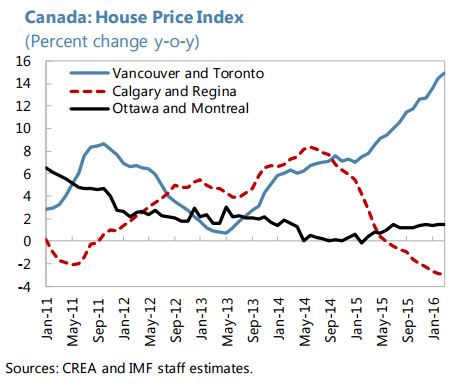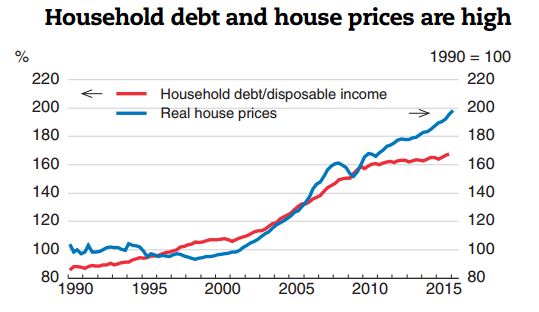Thursday, June 16, 2016
Canada’s Housing Market
Below is an extract from the IMF’s latest report on Canada:
The oil shock has caused housing market trends to “trifurcate” (…). So far, there has been no contagion risk between the diverging markets.
Resource provinces (Alberta and Saskatchewan, accounting for 23 percent of national GDP)
- Alberta’s economy has contracted by an estimated 4 percent in 2015 and is projected to shrink by another 1.6 percent in 2016.
- House prices in Calgary and Regina have fallen by 3– 4 percent from their peak in 2014 and rental vacancies have quadrupled within the span of one year (October 2014–2015). The decline in house prices followed a massive housing market boom in the mid-2000s when house prices soared by 200 percent (2004–07). With little prospect for a quick recovery in oil prices in the near term, house prices in these regions are likely to continue to trend downward.
- Alberta and Saskatchewan account for 21 percent of total household debt (2012–14) and uninsured mortgages are non-recourse loans. 2 So far, strategic defaults have not occurred in any significant way. Consumer insolvencies have increased by 40 percent over the past year but remain small as a share of total loans (Figure 5).
Non-resource provinces (British Columbia and Ontario, accounting for 49 percent of national GDP)
- British Columbia and Ontario are expected to grow by 2–3 percent this year.
- House prices have been growing by 10–20 percent year-on-year, fueled by cheap borrowing costs, demographic pressures, land supply constraints and foreign demand. Ad hoc survey data suggest that in 2015 Chinese investors accounted for 14 percent of total sales volume ($9 billion) in Toronto and 33 percent of total sales ($12.7 billion) in Vancouver.
Both British Columbia and Ontario account for 55 percent of total housing debt. Rest of Canada (accounting for 28 percent of national GDP)
- In Quebec where the economy has been growing at about 1 percent, house prices (Montreal) have been rising at a more moderate pace of 1–2 percent. Quebec and the Atlantic provinces account for 24 percent of total household debt.

The IMF’s report on Canada also includes the following:
- Figures: Housing Sector Vulnerabilities Have Increased (pg. 40)
- Table: Heat Maps of Regional Housing Markets (pg. 50)
- Annex: Housing-Related Measures to Safeguard Financial Stability (pg. 62)
A separate new report from the OECD points out that “vulnerabilities related to housing and household debt are still increasing, albeit at a slower pace.” According to the report, “Low interest rates have encouraged further increases in household credit, with household debt continuing to edge up from already high levels. Canadian house prices have risen sharply, especially in Vancouver and Toronto, and housing investment is unusually high as a share of GDP, posing vulnerabilities and squeezing middle-class families in these high-priced markets. In response to these developments, the authorities have deployed some targeted macro-prudential measures, but further regionally focused measures should be considered.”

Posted by at 5:00 AM
Labels: Global Housing Watch
Subscribe to: Posts